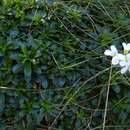en
names in breadcrumbs


Arabis ferdinandi-coburgii (lat. Arabis ferdinandi-coburgii) - kələmçiçəyikimilər fəsiləsinin ərəbotu cinsinə aid bitki növü.
Arabis ferdinandi-coburgii (lat. Arabis ferdinandi-coburgii) - kələmçiçəyikimilər fəsiləsinin ərəbotu cinsinə aid bitki növü.
Arabis ferdinandi-coburgii ist eine Pflanzenart aus der Familie der Kreuzblütler (Brassicaceae).
Arabis ferdinandi-coburgii ist eine immergrüne, ausdauernde, krautige Pflanze, die Wuchshöhen von 5 bis 20 Zentimeter erreicht. Sie bildet oberirdische Ausläufer. Die Stängelblätter sind matt, ganzrandig und aufgrund von Gabelhaaren am Rand weiß gesäumt.
Die Blütezeit reicht von April bis Mai.
Die Chromosomenzahl beträgt 2n = 18.[1]
Arabis ferdinandi-coburgii kommt endemisch im Pirin-Gebirge in Bulgarien vor. Die Art wächst in subalpinen Felsfluren.
Arabis ferdinandi-coburgii wird selten als Zierpflanze für Steingärten und als Bodendecker genutzt. Die Art ist seit 1903 in Kultur.
Arabis ferdinandi-coburgii ist eine Pflanzenart aus der Familie der Kreuzblütler (Brassicaceae).
Arabis ferdinandi-coburgii is a species of flowering plant of the genus Arabis belonging to the family Brassicaceae.[1] It was described in 1903 by Johann Kellerer and Franz Sündermann and was named after Tsar Ferdinand I of Bulgaria.
The stem of the plant is 6–12 cm high. The inflorescence is apical and racemose. Its colour iswhite. Petals reach a length of 7–9 mm and have an oblong obovate shape. The fruits are bare linear pods, the seeds are brown. Arabis ferdinandi-coburgii blooms in June–July, fruiting in August–September. It is pollinated by insects.[2]
This plant is endemic to the Pirin mountain range of Bulgaria,[2][3] where it grows in the high mountain belt on calcareous rocky and stony terrains - rocky meadows, terraces and rock crevices. Populations are spatially isolated, fragmented, formed by single plants or small groups of several individual plants.[2]
It is found at altitudes between 2,000 m and 2,800 m on the slopes of the summits of Vihren, Banski Suhodol, Bayuvi Dupki and Kamenitisa, Razlozhki Suhodol, the cirque Golemiya Kazan, and the Sredonosa ridge, all situated in northern Pirin, within the limits of Pirin National Park.[2]
Arabis ferdinandi-coburgii is a species of flowering plant of the genus Arabis belonging to the family Brassicaceae. It was described in 1903 by Johann Kellerer and Franz Sündermann and was named after Tsar Ferdinand I of Bulgaria.
The stem of the plant is 6–12 cm high. The inflorescence is apical and racemose. Its colour iswhite. Petals reach a length of 7–9 mm and have an oblong obovate shape. The fruits are bare linear pods, the seeds are brown. Arabis ferdinandi-coburgii blooms in June–July, fruiting in August–September. It is pollinated by insects.
This plant is endemic to the Pirin mountain range of Bulgaria, where it grows in the high mountain belt on calcareous rocky and stony terrains - rocky meadows, terraces and rock crevices. Populations are spatially isolated, fragmented, formed by single plants or small groups of several individual plants.
It is found at altitudes between 2,000 m and 2,800 m on the slopes of the summits of Vihren, Banski Suhodol, Bayuvi Dupki and Kamenitisa, Razlozhki Suhodol, the cirque Golemiya Kazan, and the Sredonosa ridge, all situated in northern Pirin, within the limits of Pirin National Park.
Gęsiówka macedońska, g. wczesna (Arabis ferdinandi-coburgii) – gatunek byliny należący do rodziny kapustowatych. Pochodzi z Europy Południowej (Bułgaria, Rumunia. Macedonia)[3]. W Polsce jest uprawiana jako roślina ozdobna.
Roślina ozdobna nadająca się do ogrodów skalnych i jako roślina zadarniająca. Szczególnie dobrze komponuje się pomiędzy kamieniami i na murkach.
Gęsiówka macedońska, g. wczesna (Arabis ferdinandi-coburgii) – gatunek byliny należący do rodziny kapustowatych. Pochodzi z Europy Południowej (Bułgaria, Rumunia. Macedonia). W Polsce jest uprawiana jako roślina ozdobna.
Arabis ferdinandi-coburgii é o nome científico de uma planta da família das Brassicaceae (a que também pertencem as couves, os nabos e a mostarda), utilizada em jardins, especialmente em locais rochosos e facilmente drenáveis. Tem uma forte resistência à secura. As suas folhas armazenam alguma água. As folhas são matizadas de verde-dourado (ouro-velho, segundo a designação popular da espécie, em inglês). As flores, pequenas, são brancas.
Pode ser encontrada em países da Europa Central, incluindo a Alemanha e a Bulgária.[1]
Arabis ferdinandi-coburgii é o nome científico de uma planta da família das Brassicaceae (a que também pertencem as couves, os nabos e a mostarda), utilizada em jardins, especialmente em locais rochosos e facilmente drenáveis. Tem uma forte resistência à secura. As suas folhas armazenam alguma água. As folhas são matizadas de verde-dourado (ouro-velho, segundo a designação popular da espécie, em inglês). As flores, pequenas, são brancas.